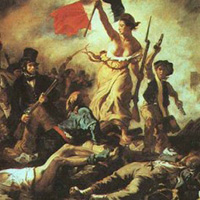Well, That Escalated Quickly: How Content Fueled the French Revolution
 Yesterday, a grand military parade marched the streets of Paris while flags of blue, white and red hung from trees and booming fireworks exploded behind the Eiffel Tower in a dazzling display. It was Bastille Day—a celebration of independence that commemorates the beginning of the French Revolution.
Yesterday, a grand military parade marched the streets of Paris while flags of blue, white and red hung from trees and booming fireworks exploded behind the Eiffel Tower in a dazzling display. It was Bastille Day—a celebration of independence that commemorates the beginning of the French Revolution.
I would think that most of us have had at least one history class that covered this historic event. (Need a refresher? I recommend this music video by Jeffrey Lewis). We know the lower class, the Third Estate, was tired of being oppressed and forced to carry the weight of the country while everyone else benefited from their hard work. So, they revolted. What you may not realize, though, is how content effectively mobilized and supported the Third Estate during the revolution.
Of course, written content in itself was nothing new, but its pivotal shift from an upper class luxury to an everyman necessity provided the lower class with what they needed to stay informed and energized through the revolution. So how did the content creators of the day engage and fuel their new audience?
Increased Volume
In the years leading up to the French Revolution, the size of the Third Estate had grown dramatically. They made up over 95% of the population. If the content that was previously reserved for the rich was going to reach common people, it needed a new format and process, which is exactly what happened. As Rolf Reichardt writes, “If the number of political bulletins in France before the Revolution could be counted on one hand, it soon mushroomed to over three hundred weekly and daily newspapers between July 1789 and 1790.”
A New Language
Because a majority of the Third Estate was uneducated, the language or vocabulary used in previous publications was out of touch. They needed new writers who could create content in a way that appealed to the lower class. Some who produced pamphlets did this by using well-known theatre characters, in particular those who represented the common man, as a spokesperson for the cause; they knew the people would respond to the words of someone who represented them.
Different Mediums
For some of the least educated, though, reading pamphlets and newspapers wasn’t an option because they were illiterate. No increase in volume or change of vocabulary would help. In response, there was a growth of what Reichardt calls “picture journalism.” Yes, even in the 18th century, they realized how important it was to offer a visual option, something we’re still reminding readers of today. To keep this particular audience engaged in the causes of the revolution, the pictures could depict past victories, such as the storming of Bastille, or point toward future triumph with cartoonish figures of clergy and aristocrats being ruled by the Third Estate.
Today, we often have to make similar changes to ensure our content is far-reaching, conveys the right message and offers a variety of avenues for access. Sometimes, “content” may seem like just another marketing buzzword, the latest trend in selling goods, services or ideas. But, in reality, using content as a marketing tool can be easily traced throughout history, proving its success and sustainability.
Are you rethinking your content strategy now? Trying to reach a new audience or an existing audience more successfully? Let us help!
Faith Jones – Writer & Editor



